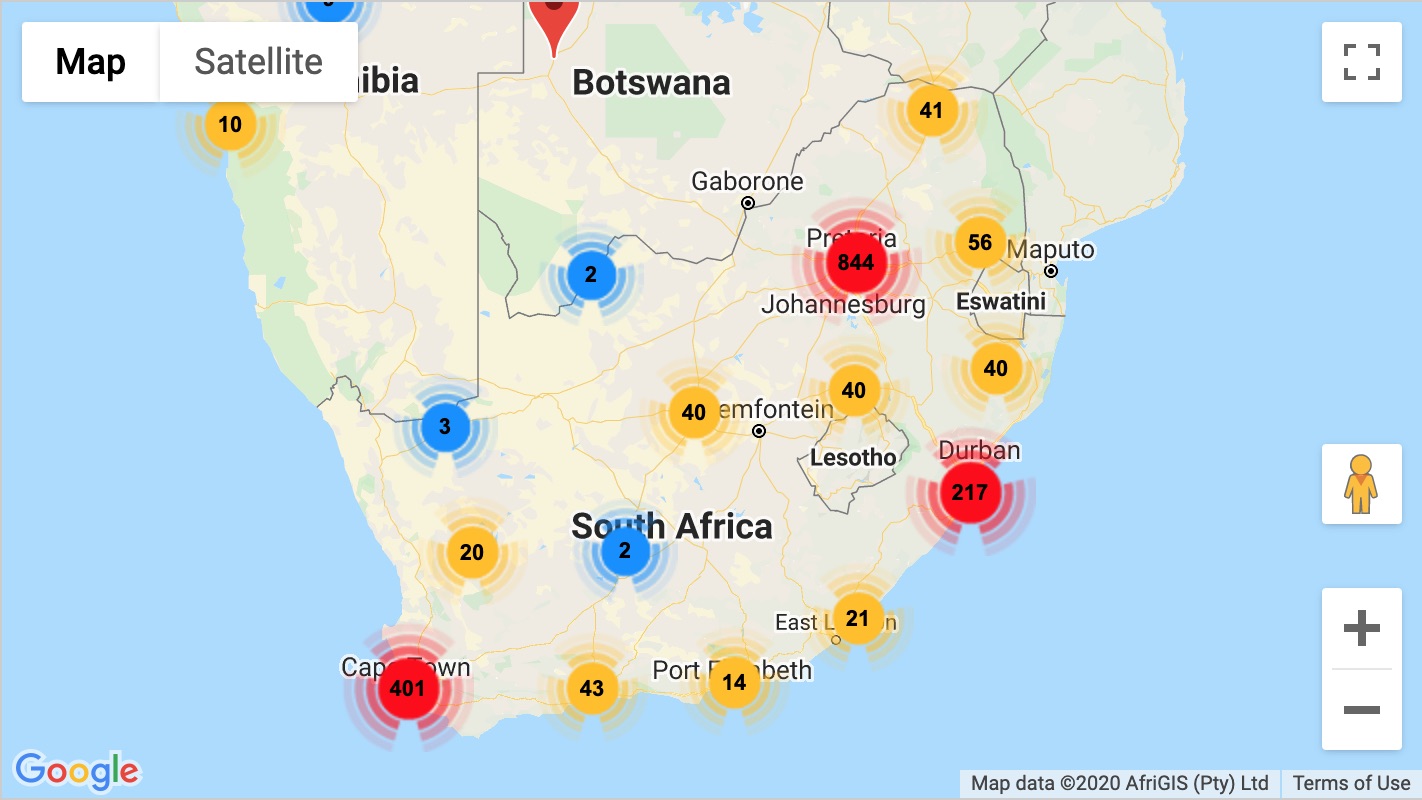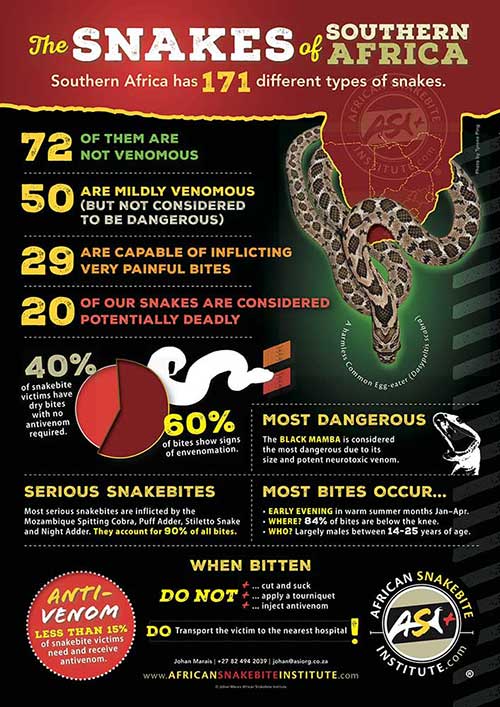PLEASE NOTE. Our offices will be closed from the 12th of December 2025 – until the 5th of January 2026. Last date for orders will be the 8th of December 2025. Any orders placed after the 8th of December 2025, will only be dispatched after the 5th of January 2026.

The genus Bitis comprises of 18 species restricted to Africa with the exception of the Puff Adder (Bitis arietans) which has a limited distribution on the Arabian Peninsula. Of these 18 species, 12 are considered Dwarf Adders. Southern Africa has 10 of the 12 Dwarf Adders. The two exceptions are the Angolan Dwarf Adder (Bitis heraldica) found in the highlands of Angola and the Kenyan Horned Adder (Bitis worthingtoni) occuring in the highlands of Kenya. The six other species of larger adders are: Puff Adder (Bitis arietans), Gaboon Adder (Bitis gabonica), Rhino Viper (Bitis rhinoceros), River Jack (Bitis nasicornis), Ethiopian Mountain Adder (Bitis parviocula) and the newly described Harenna’s Adder (Bitis harenna) from Ethiopia.
The dwarf adders in southern Africa are very diverse, with some being widespread across southern Africa such as the Horned Adder (Bitis caudalis) and others being restricted to a tiny area or single mountain range such as the Albany Adder (Bitis albanica) or the Plain Mountain Adder (Bitis inornata). Three of the dwarf adders have been listed by the IUCN as of conservation concern. The dwarf adders have many threats, from overgrazing and agricultural development to roadways, industrial developments, mines and illegal collection for the pet trade. Luckily many species occur in provincial or national parks and local reserves, but others still require protection.
We will discuss the ten species of dwarf adder that occur in southern Africa and key features for their identification. In many cases distribution is very important and must be taken into consideration before tackling an identification. Juvenile Puff Adders (Bitis arietans) can sometimes be confused with the dwarf adders and it would be worth getting to know the features of the Puff Adder to avoid confusion.
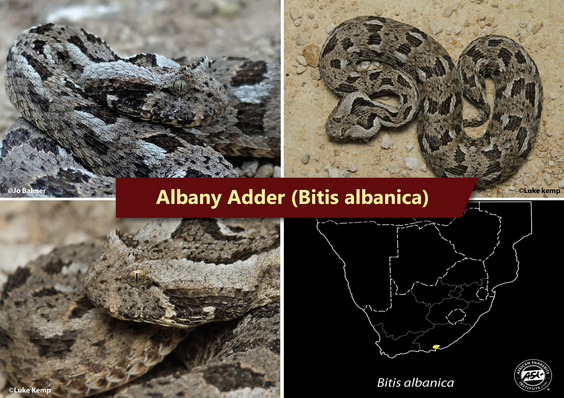
Albany Adder (Bitis albanica)
Described as a subspecies Bitis cornuta albanica by John Hewitt in 1937 from specimens collected around Grahamstown in the Eastern Cape. Bill Branch elevated it to a full species in 1997 as Hewitt never released a formal description. This is a small species averaging around 25cm but with a maximum length of just over 30cm. Less than 20 specimens have ever been found or recorded and so the IUCN has listed it as critically endangered. The Albany Adder is light grey adder with a series of around 20 paired black blotches/butterfly-markings with a pale edge down the back. The head has a black arrow with two points. There is a dark stripe running from the eye to the back of the head and usually two to three pale streaks below the eye. Above each eye is a series of scales forming tufts of reduced horns.
This species appears to be restricted to the Algoa Bay region of the Eastern Cape in open grassland mosaic and succulent thicket. The venom of the Albany Adder is unknown but expected to be similar to other species of the genus having cytotoxic properties. Swelling is expected, but due to its size, it is not expected to be life threatening.
This species can be identified based on distribution as no other dwarf adders are known from this area. There are historical records of Berg Adder (Bitis atropos) from the Port Elizabeth region of Eastern Cape, but the markings down the back are generally not paired and don’t touch like those of the Albany Adder. Additionally, Berg Adders do not have tufts of scales above the eyes.
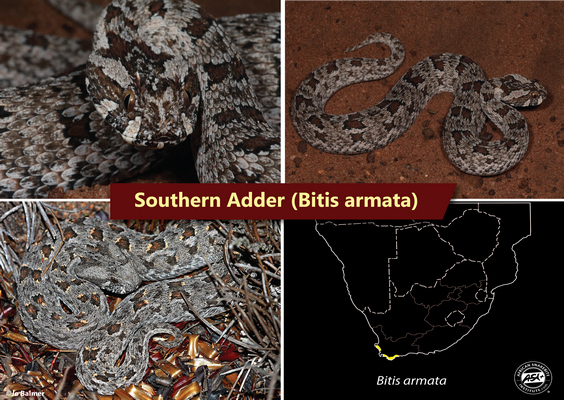
Southern Adder (Bitis armata)
Described by Sir Andrew Smith in 1826 and collected around the Cape colony. This medium sized adder reaches a length of around 42cm, but averages at around 30cm. The IUCN has listed the Southern Adder as vulnerable due to the limited habitat around the Cape. Colour is greyish brown with around 22 dark blotches down the back. Juveniles can often have orange around the blotches. The head has two split V’s behind each eye. Above each eye has a series of 4-7 tufts forming reduced horns like the Albany Adder.
This species is restricted to low lying coastal dune thickets and fynbos below 300m above sea level (asl). It occurs along the coast east and west of Cape Town in the Western Cape. The venom of the Southern Adder is unknown, but assumed to be cytotoxic causing swelling, but not life threatening.
The Southern Adder can be identified based on distribution. Although both Berg Adder (Bitis atropos) and Red Adder (Bitis rubida) overlap or occur nearby, both species are found on rocky habitat and not coastal thicket. The Southern Adder has the lowest ventral scale count of all the dwarf Bitis. The Southern Adder has two V’s on the head whereas the Red Adder usually has a single dark marking.
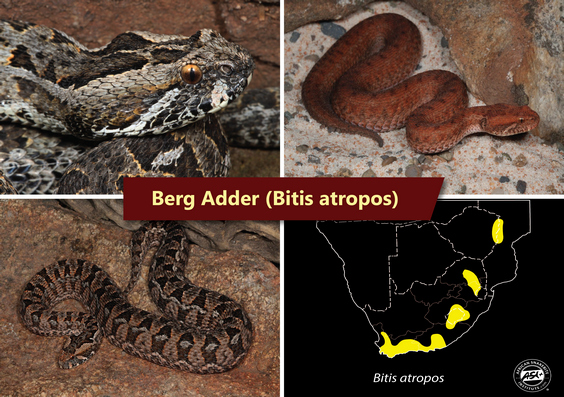
Berg Adder (Bitis atropos)
One of the first Dwarf Adders described in 1758 by Carolus Linnaeus from the Cape. Fitzsimons named the Transvaal population Bitis atropos unicolor in 1959, as there is a red phase that occurs high up on the Mpumalanga escarpment. It has been proposed that the Berg Adder will be split into four separate species based on each isolated population. The Berg Adder reaches around 60cm, but averages around 30 – 40cm. Colours and markings are variable between each population. In the Cape and Drakensberg, specimens are usually boldly marked with Cape specimens usually being darker grey and Drakensberg individuals more of a brown colour. Specimens from Mpumalanga and Limpopo can be plain or well patterned and occur from red to grey/brown. The Zimbabwe population in the Eastern Highlands are usually well patterned and an orange/brown colour.
The venom of the Berg Adder is nasty and a mix of neurotoxins and cytotoxins. The facial and optic nerves are usually affected, with dropping eye lids (ptosis), severe salivation, lack of taste and smell and dilated pupils. Effects can last from weeks to months or even years. At least one victim has lost his sight permanently. Antivenom is not effective against the venom and bites are treated symptomatically. There are no confirmed deaths to date, but a bite from a large Berg Adder to a small child may be severe. These snakes occur across the Eastern escarpment, generally on high altitude mountains. In the Cape region Berg Adders occur down to sea level. Berg Adders occur in four distinct populations (Cape, Drakensberg, Mpumalanga/Limpopo and eastern highlands of Zimbabwe).
The Berg Adder can be identified by a few characteristics. The head is usually not as angled as the other dwarf adders. The blotches down the back are usually paired and triangular often with a pale line bordering the blotches.
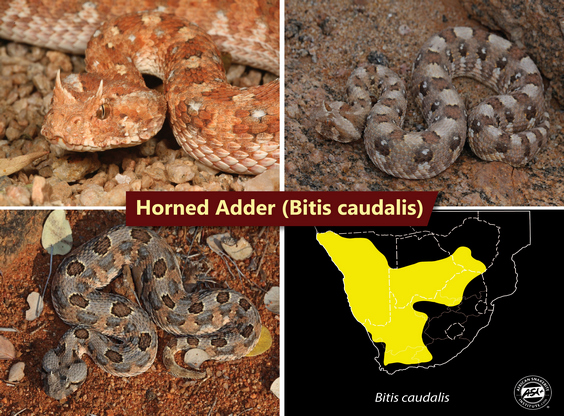
Horned Adder (Bitis caudalis)
Described by Sir Andrew Smith in 1839 from the Karoo just north of the Cape. The Horned Adder averages around 30 – 40cm but can reach 60cm. They are very varied in colour from grey to brown, yellow to red/orange and with rhombic, elliptical or square splotches. The horns are usually very prominent, but hornless individuals do occur. There are usually two lighter patches on the edges of the head from the eye to the start of the neck bordered by a darker stripe. Males tend to be more vividly coloured than females.
The venom of the Horned Adder is cytotoxic, causing severe swelling and occasionally necrosis. The venom is not life threatening and antivenom is not required. The Horned Adder is the most widespread dwarf adder in southern Africa, going further north into Angola. They are common in the dry regions of the western half of southern Africa in the Karoo, Namaqualand, the Namib desert, Kalahari and up into the flats of Limpopo and northern Gauteng.
The Horned Adder is usually easily identified by the prominent horns above each eye, but where hornless individuals occur, there may be confusion. In regions of Namibia there are individuals that appear to be hybrids with Péringuey’s Adder (Bitis peringueyi).
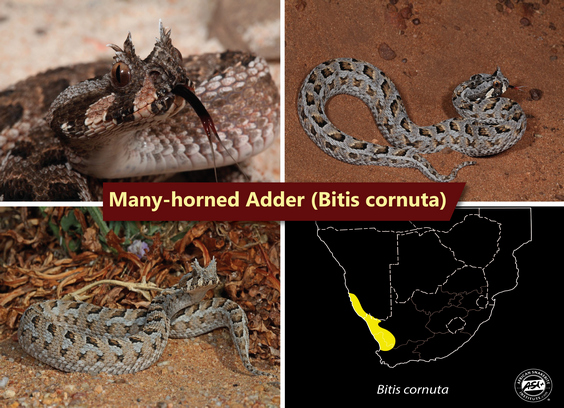
Many-horned (Bitis cornuta)
The Many-horned Adder was described by François Marie Daudin in 1803 from a specimen found in Port Nolloth in 1777 by Paterson. The Many-horned Adder is a large Dwarf Adder reaching just over 50cm, although captive snakes have exceeded 70cm. Body colour is brownish to grey/blue with a series of paired dark squares with light grey edges. 3 – 8 clusters of scales form prominent horns above each eye. There are two pale stripes below the eye and a dark arrow-like marking on the head.
The venom of the Many-horned Adder is cytotoxic, causing pain and swelling and occasionally necrosis. Antivenom is not required and patients are treated symptomatically. The Many-horned Adder is restricted to the Namaqualand region from the northern region of the Western Cape, through the Northern Cape into southern Namibia, occurring in rocky regions as well as sandy coastal planes.
The Many Horned Adder is often confused with the Red Adder (Bitis rubida) having similar markings and patterns. The two species do not overlap and snakes in the Cederberg are Red Adder and not Many-horned Adders as has previously been confused. The tufts of scales above each eye distinguish this species from all other Dwarf Adders.
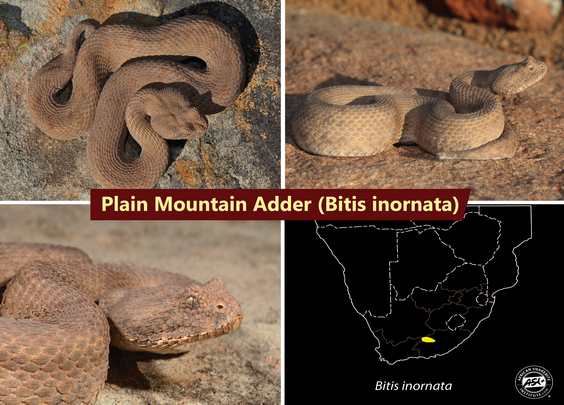
Plain Mountain Adder (Bitis inornata)
Described by Sir Andrew Smith as far back as 1838 from the Sneeuberg near Graaf-Reinet in the Eastern Cape. Less than ten Plain Mountain Adders have been found making it listed as Endangered by the IUCN. This medium sized adder averages around 25 – 40cm with a max length of 45cm. As the name suggests, this adder is plain shades of brown with splotches of faint red. There are reduced clusters of scales above each eye.
Nothing is known of the venom of this species, but it is assumed to be the same as the other dwarf adders being cytotoxic with swelling and pain. The Plain Mountain Adder is restricted to the Sneeuberg mountain range in the western Eastern Cape from around Craddock to Graaf-Reinet. It is restricted to grasslands above 1500m asl, an area that receives annual snow.
Previously confused with the red variation of the Red Adder (Bitis rubida) from the Cederberg. No other dwarf adder occurs in the same region or at least the high altitude without patterns.
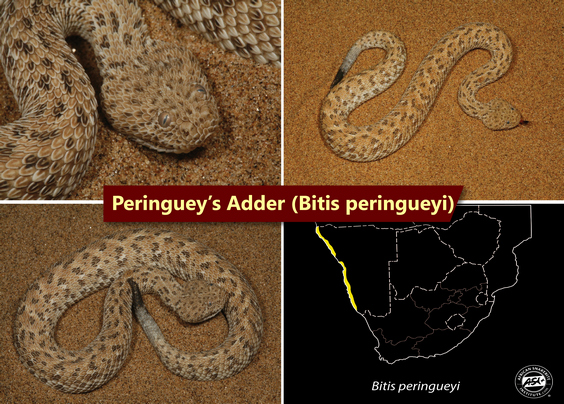
Péringeuy’s Adder (Bitis peringueyi)
Described by George Albert Boulenger in 1888 from Walvis bay in Namibia. This is one of the smallest adders after the Namaqua Dwarf Adder, averaging around 20 – 25cm, and reaching around 33cm. The Péringeuy’s Adder is usually sandy brown to orange or grey in colour with a series of black and white flecks. The eyes are situated on top of the head and are just visible when the snake buries itself into soft sand. The tip of the tail is often black in colour and may be used for caudal luring to attract prey such as lizards.
The venom is mildly neurotoxic and cytotoxic, causing swelling and pain. It is not life threatening and antivenom is not required. This species occurs up the coast of Namibia into southern Angola. It occupies the soft wind-blown dunes of the Namib desert coast, where it buries into the sand or the sparse bush vegetation to ambush lizards.
A very unique looking dwarf adder that isn’t easily confused with other species. There appears to be a Horned Adder x Péringeuy’s Adder hybrid in certain parts of Namibia.
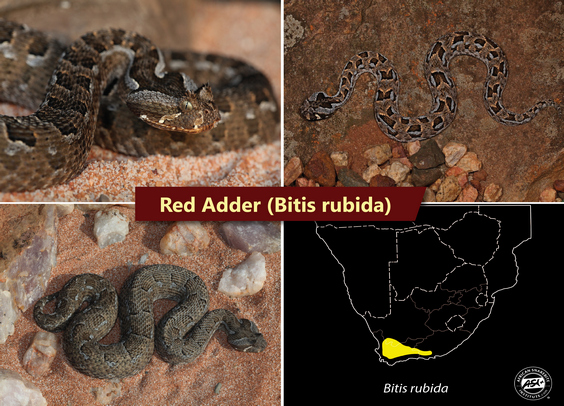
Red Adder (Bitis rubida)
Described by Bill Branch as recently as 1997 collected from the Cederberg. It is an averaged sized dwarf adder of around 30cm but may exceed 40cm. A very varied species from brick red to well patterned with black and grey. It appears as though the red variety is restricted to the Cederberg, whereas the well patterned individuals are widespread. There may be tufted horns above each eye, but hornless specimens are also found.
The venom is unknown, and bites are expected to be similar to most of the other dwarf adders with swelling and pain. The Red Adder is known from the Cape Fold Mountains from the Cederberg in the north into the Swartberg, Langberg and Baviaans mountains. It occurs in rocky mountain fynbos.
This is probably one of the hardest dwarf adders to tell apart. They are widespread in the Cape Fold Mountains and have similar markings to the Albany Adder, Southern Adder and Many-horned Adder. But the Red Adder only occurs at higher elevations in the same area as the Berg Adder, whereas the other three similar species are restricted to low land regions. The red colour variety cannot be confused with any other dwarf adder species in the region.
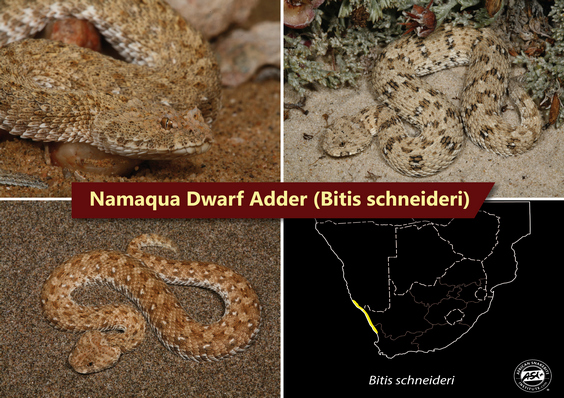
Namaqua dwarf Adder (Bitis schneideri)
Described by Oskar Boettger in 1886 from southern Namibia. This is the smallest adder in the world with a maximum size of 28cm, but is usually only around 20cm in length. It is a plain sandy brown to grey and almost orange in some areas with black and white specks and blotches that help it be camouflaged in the sandy areas it occupies
The venom of this species is mildly cytotoxic, causing swelling and pain. No antivenom is required and treatment of patients is for pain. The Namaqua Dwarf Adder is restricted to the coastal dunes from the Western Cape up the coast into southern Namibia. They are restricted to within about 20km from the coast and require soft sand to bury in. They occur in sandy dunes and are well known for burrowing into the sand to ambush lizards and other prey.
This is quite a unique looking dwarf adder and can only be confused with the Péringeuy’s Adder, but the position of the eyes and shape of the head easily separate them.
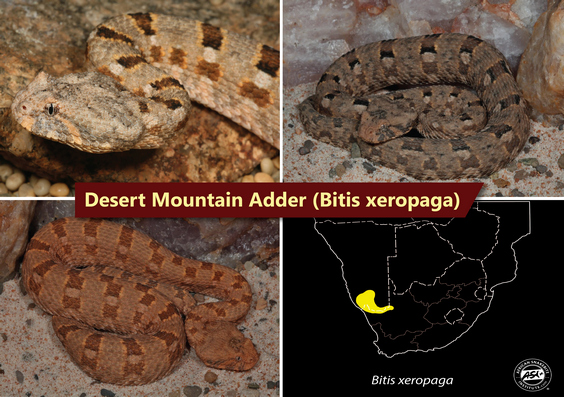
Desert Mountain Adder (Bitis xeropaga)
This species was described in 1975 by Wolf Haacke of the Transvaal museum from a specimen collected in the Richtersveld, Northern Cape. A large adder with a maximum length of 61cm, but averages around 40 – 50cm. Body colour is usually grey to brown but can be almost black or orange with a series of dark squares edged with yellow or orange and flanked with a pale stripe. The head usually has a bit of grey under the eye and a cream coloured stripe or two.
The venom of this species is both neurotoxic and cytotoxic and causes pain and swelling but in children may affect breathing. Antivenom is not required and patients are treated for pain, while breathing must be monitored when small children are bitten. This species occupies the dry rocky mountains of the Orange River valley into the Fish River Valley and southern Namibia. It lives between the rocks of thinly vegetated mountain slopes, using its excellent camouflage to ambush prey.
This species is unique in colour and pattern and cannot be confused for other species. The Horned Adder and Many-horned Adder overlap in distribution with the Desert Mountain Adder but can be told apart as the Desert Mountain Adder lacks horns.
Search
Shopping Cart
CONTACT US:
Product enquiries:
Caylen White
+27 60 957 2713
info@asiorg.co.za
Public Courses and Corporate training:
Michelle Pretorius
+27 64 704 7229
courses@asiorg.co.za
Featured Products
-
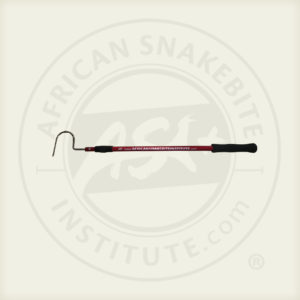 ASI Collapsible Snake Hook - 1.2 m
R650.00
ASI Collapsible Snake Hook - 1.2 m
R650.00
-
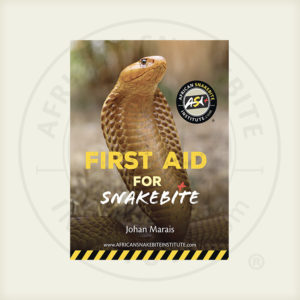 ASI First Aid for Snakebite Booklet
R40.00
ASI First Aid for Snakebite Booklet
R40.00
-
 Rangers Book Combo 2
Rangers Book Combo 2
R2,080.00Original price was: R2,080.00.R1,870.00Current price is: R1,870.00.
